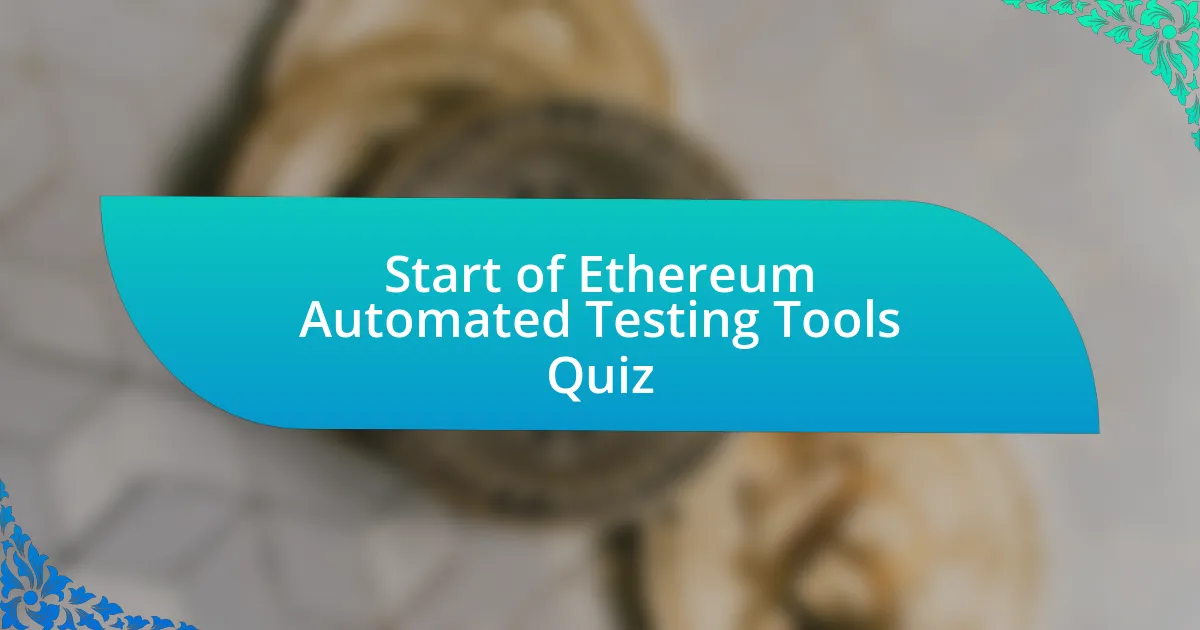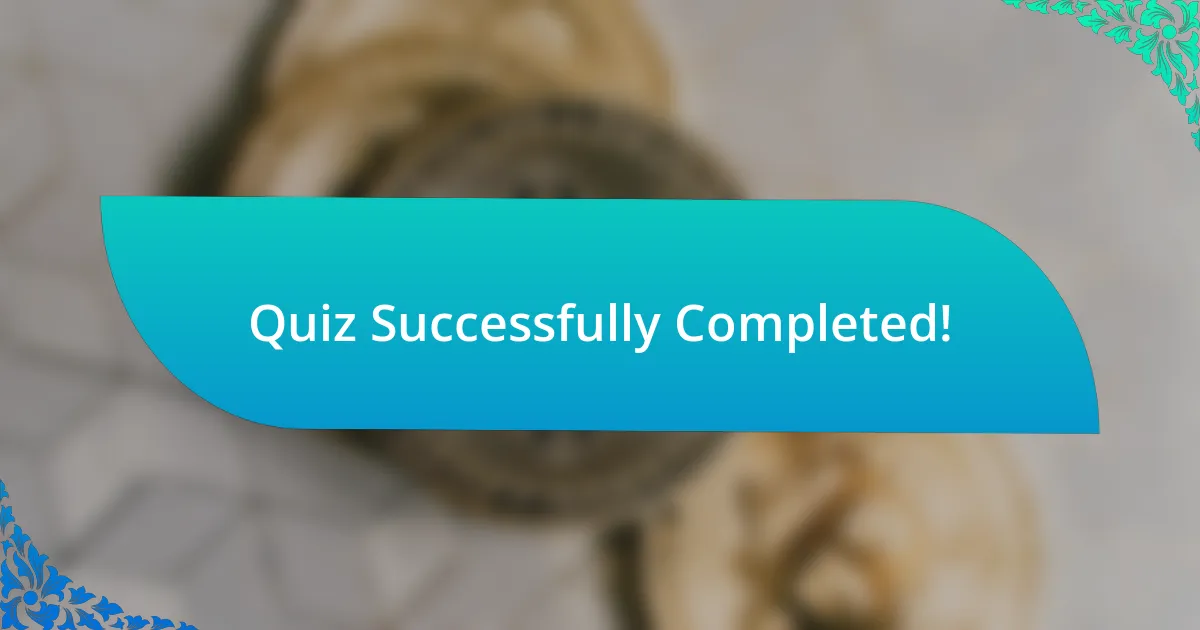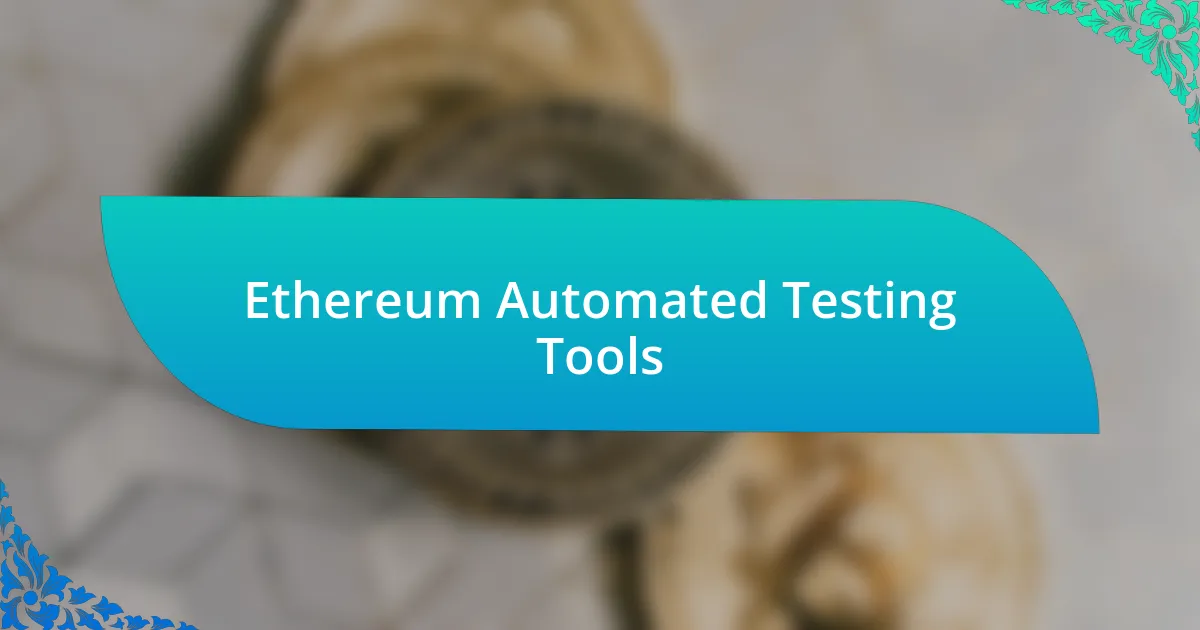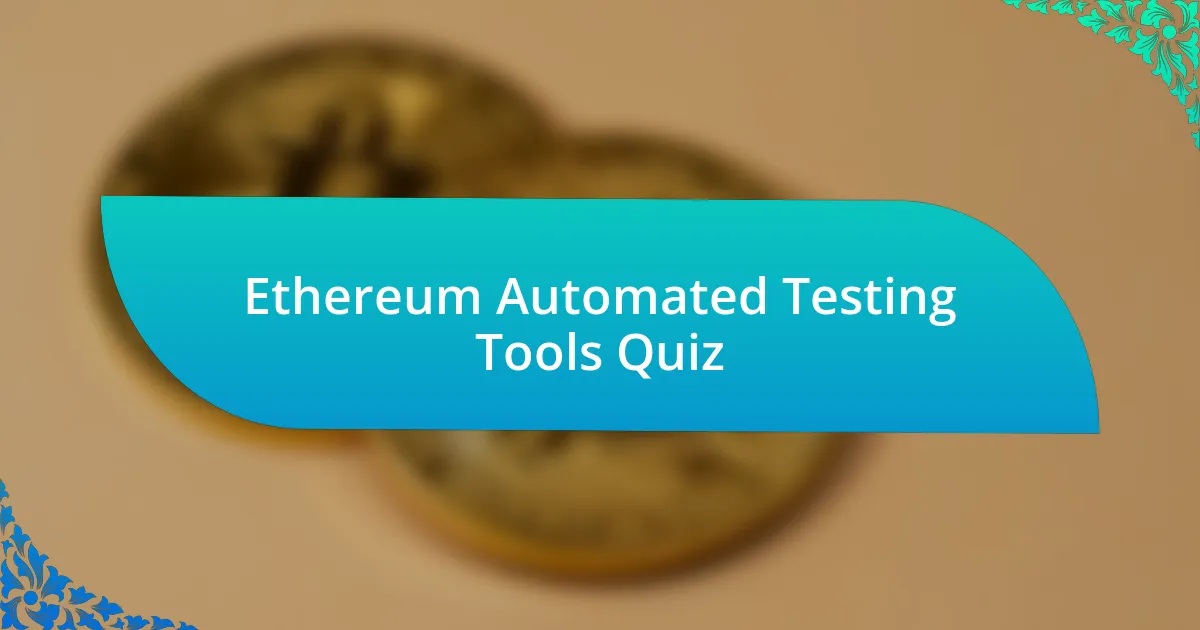
Start of Ethereum Automated Testing Tools Quiz
1. What is Truffle used for in Ethereum development?
- It is a testing framework for Ethereum smart contracts.
- It is a mining software for Ethereum transactions.
- It is a cryptocurrency wallet for storing tokens.
- It is a blockchain protocol for decentralized applications.
2. How does Ganache enhance local testing for Ethereum developers?
- Ganache provides a personal Ethereum blockchain for testing.
- Ganache monitors network traffic for security.
- Ganache generates transaction fees for testing.
- Ganache compiles smart contracts for deployment.
3. What kind of functionality does Chai provide for smart contract testing?
- Language for writing blockchain code
- Framework for deploying smart contracts
- Assertion library for comparing test outcomes
- Tool for creating Ethereum nodes
4. In what ways does Mocha assist with Ethereum testing frameworks?
- Mocha provides a GUI for blockchain analysis.
- Mocha allows testing of asynchronous code.
- Mocha helps in designing blockchain user interfaces.
- Mocha enables automated smart contract deployment.
5. What is the primary use of Web3.js in Ethereum applications?
- Analyze blockchain data for performance metrics
- Create a new blockchain network for Ethereum developers
- Facilitate communication between front-end developers and Ethereum nodes using JavaScript APIs
- Generate smart contracts automatically for Ethereum transactions
6. What testing advantages does Truffle offer to developers?
- Exclusively for large team collaborations.
- Limited support for smart contract deployment.
- Ease of use and robust testing capabilities.
- Focus on manual testing procedures.
7. How does Ganache allow for the simulation of multiple accounts?
- Ganache provides a suite of accounts for testing.
- Ganache requires manual account creation each time.
- Ganache allows unlimited transaction speeds during tests.
- Ganache only simulates one account for every run.
8. What are the main features of Hardhat as a development tool?
- Hardhat has no debugging capabilities and only allows for remote development with public networks.
- Hardhat is only a front-end framework with limited testing features and no plugin support.
- Hardhat functions solely as a deployment tool without any local network features or automation tasks.
- Hardhat features include a local Ethereum network, advanced debugging capabilities, a plugin system, and built-in tasks for automation such as contract compilation and deployment.
9. What benefits does Hardhat provide in terms of debugging?
- Enhanced stack traces
- Integrated version control
- Built-in cryptocurrency wallet
- Automatic code formatting
10. How does Remix IDE facilitate effective testing and deployment of contracts?
- Remix IDE supports testing and deployment through its web-based interface, real-time code analysis, and built-in debugging tools.
- Remix IDE provides automatic code generation and external database integration for developer convenience.
- Remix IDE allows development through its native file storage and advanced network connectivity.
- Remix IDE facilitates contract creation via its command-line interface and third-party API integration.
11. What are the notable limitations of using Ganache for larger teams?
- It is focused on individual developers.
- It has built-in support for version control.
- It supports real-time team collaboration.
- It allows remote access to the blockchain.
12. In what way does Mocha ensure independent execution of test cases?
- Mocha uses a testing framework with hooks
- Mocha disables setTimeout during tests
- Mocha combines test results into one output
- Mocha runs all tests in random order
13. How does Chai`s readability benefit developers during testing?
- It only supports testing for specific programming languages.
- It simplifies writing and understanding test code.
- It generates automated test cases without developer input.
- It eliminates the need for testing altogether.
14. Why is it significant to use a local Ethereum network for smart contract testing?
- It is used for deploying contracts to production.
- It connects directly to the Ethereum mainnet.
- It requires interaction with external APIs for testing.
- It allows for controlled and rapid testing environments.
15. What distinct features set Hardhat apart from other development environments?
- Hardhat does not support advanced debugging tools.
- Hardhat is limited to only testing smart contracts.
- Hardhat cannot automate tasks like contract deployment.
- Hardhat features a plugin system that enhances its functionality.
16. How does Remix IDE`s real-time analysis contribute to contract development?
- It allows for animated visualizations of contract interactions.
- It provides instant feedback on code errors and warnings.
- It restricts access to external libraries and frameworks.
- It generates automatic contract documentation and reports.
17. What role does the `Deploy and Run Transactions` feature serve in Ganache?
- The purpose of the `Deploy and Run Transactions` pane in Ganache is to allow developers to easily interact with their contracts during testing.
- The `Deploy and Run Transactions` pane in Ganache allows for generating new Ethereum addresses automatically.
- The `Deploy and Run Transactions` feature in Ganache is designed exclusively for monitoring network statistics.
- The `Deploy and Run Transactions` feature in Ganache is used for optimizing smart contract code for production.
18. What aspects of code does Remix IDE`s built-in debugger analyze?
- Network speed and latency
- User interface and design patterns
- Code execution flow and state changes
- Database structure and queries
19. How can developers customize block times using Ganache?
- Ganache does not support block time customization.
- Ganache sets a fixed block time automatically.
- Ganache requires coding for block time changes.
- Ganache allows developers to adjust the time between blocks.
20. What are Hardhat`s capabilities in automating testing tasks?
- Hardhat automates tasks like contract compilation and deployment.
- Hardhat provides a GUI for managing Ethereum transactions.
- Hardhat exclusively supports off-chain data testing.
- Hardhat requires manual setup for each testing environment.
21. What considerations should be taken when using Hardhat`s plugins?
- Use plugins without testing them first.
- Ignore the plugin documentation entirely.
- Consider the compatibility and stability of plugins.
- Only select plugins based on popularity.
22. How does Mocha manage the order of test case execution?
- Mocha does not manage test case execution order.
- Mocha executes functions in a predetermined sequence.
- Mocha runs test cases in random order.
- Mocha executes all test cases simultaneously.
23. What kind of support does Web3.js offer for Ethereum front-end development?
- Manages user data on the Ethereum network
- Operates as a blockchain mining tool
- Creates smart contracts for the blockchain
- Provides APIs for interacting with Ethereum nodes
24. What advantages does Truffle provide in regard to automated deployment?
- Limitations in local testing environments
- Complex user interface that hinders usage
- Support for automated testing and deployment of smart contracts
- Lack of integration with other blockchain tools
25. What specific testing scenarios benefit from Ganache’s multiple account support?
- Tracking on-chain analytics
- Simulating different transaction scenarios
- Managing user permissions easily
- Analyzing gas fees quickly
26. What unique feature allows Remix IDE to support deployment to different networks?
- Local blockchain simulation
- Built-in code analysis
- Single network access
- Plugin architecture
27. Why might developers prefer Hardhat`s plugin system for project customization?
- It restricts developers from modifying the underlying code.
- It doesn`t allow any additional integrations with tools.
- It supports a wide range of plugins for enhanced functionality.
- It requires developers to use only predefined settings.
28. How does Chai integrate with Mocha to enhance testing processes?
- Chai provides assertion methods for Mocha test cases.
- Chai manages database connections for Mocha tests.
- Chai runs tests in parallel with Mocha.
- Chai generates test cases automatically for Mocha.
29. What kind of feedback does Remix IDE provide during real-time coding?
- Slow performance analysis
- Unavailable code suggestions
- Instant feedback on code errors
- Manual debugging suggestions
30. How does Ganache`s testing environment differ from a public Ethereum network?
- Ganache allows infinite gas for transactions, while public Ethereum limits gases.
- Ganache`s environment is visible to everyone, while public networks are private.
- Ganache requires real Ether to execute tests, unlike public Ether networks.
- Ganache operates in a controlled local environment for testing, while a public Ethereum network is decentralized and open to all.

Quiz Successfully Completed!
Congratulations on completing the quiz on Ethereum Automated Testing Tools! It’s great to see your commitment to understanding this essential aspect of Ethereum development. Throughout the quiz, you may have discovered various tools that streamline the testing process, ensuring your smart contracts operate smoothly and securely. This knowledge is crucial for any developer working within the Ethereum ecosystem.
You likely learned about different frameworks and methodologies that enhance the reliability of your code. From understanding unit tests to integration tests, each concept plays a vital role in the development life cycle. By applying these tools effectively, you can prevent costly errors and boost your confidence in the deployment of your decentralized applications.
If you’re eager to delve deeper, we invite you to explore the next section on this page. There, you’ll find comprehensive information on Ethereum Automated Testing Tools that can further enhance your skills. Expanding your knowledge in this area will not only improve your development capabilities but also keep you ahead in the rapidly evolving blockchain landscape. Enjoy your learning journey!

Ethereum Automated Testing Tools
Introduction to Ethereum Automated Testing Tools
Ethereum Automated Testing Tools are software applications designed to facilitate the testing of smart contracts on the Ethereum blockchain. These tools help developers ensure that their contracts function correctly, efficiently, and securely. By automating the testing process, developers can save time and reduce the risk of human error. The tools often incorporate various testing methodologies and frameworks specifically tailored for Ethereum’s architecture and functionality.
Key Features of Ethereum Automated Testing Tools
Key features of Ethereum Automated Testing Tools include automated testing environments, integration with development frameworks, and support for multiple testing scenarios. Many tools offer functionalities like gas usage analysis, performance monitoring, and debugging capabilities. These features enable developers to identify issues early in the development process, thereby improving the quality and reliability of smart contracts.
Popular Automated Testing Tools for Ethereum
Some popular automated testing tools for Ethereum include Truffle, Hardhat, and Brownie. Truffle is known for its comprehensive suite, which includes migration, compilation, and testing capabilities. Hardhat focuses on providing a flexible development environment with robust testing features. Brownie is widely favored in the Python community for its simplicity and integration with the Ethereum ecosystem. Each tool offers unique benefits tailored to different developer preferences.
Testing Methodologies Utilized in Ethereum
The testing methodologies utilized in Ethereum Automated Testing Tools often include unit testing, integration testing, and end-to-end testing. Unit testing focuses on individual functions within smart contracts, while integration testing examines the interactions between multiple contracts or systems. End-to-end testing assesses the overall functionality and usability of the application as a whole. These methodologies are critical in ensuring the reliability and security of Ethereum applications.
Challenges in Ethereum Automated Testing
Challenges in Ethereum Automated Testing include managing complex contract interactions, handling gas costs, and ensuring adequate test coverage. The dynamic nature of Ethereum contracts can lead to unexpected behavior if not thoroughly tested. Additionally, gas costs can impact the feasibility of certain tests, especially for extensive or iterative testing processes. Ensuring comprehensive test coverage is essential to identify vulnerabilities and improve contract performance.
What are Ethereum Automated Testing Tools?
Ethereum Automated Testing Tools are software applications designed to evaluate the functionality and security of smart contracts on the Ethereum blockchain. These tools automate testing processes by simulating various conditions under which smart contracts operate. Some widely recognized tools include Truffle, Hardhat, and MythX, which help developers identify vulnerabilities and ensure the reliability of their code before deployment. Data shows that automated testing significantly reduces bugs in production, which can lead to costly security breaches.
How do Ethereum Automated Testing Tools work?
Ethereum Automated Testing Tools work by executing predefined test scripts against smart contracts to ensure they function as expected. Developers write test cases, often in JavaScript or Solidity, that cover various scenarios, including edge cases and failure conditions. The tools simulate contract transactions and check state changes, asserting that the contract behaves correctly. For instance, Hardhat provides an environment for running tests locally, which speeds up the testing process and enhances developer productivity.
Where can developers find Ethereum Automated Testing Tools?
Developers can find Ethereum Automated Testing Tools primarily on GitHub and official websites of the respective tools. Major projects like Truffle and Hardhat have repositories that include documentation, installation guidelines, and examples. Additionally, Community forums and developer communities such as Ethereum Stack Exchange also share resources and recommendations for these tools, facilitating easier access and support.
When should developers use Ethereum Automated Testing Tools?
Developers should use Ethereum Automated Testing Tools during the development phase of smart contract projects, ideally before deployment. Implementing testing at this stage helps in catching bugs and vulnerabilities early. Continuous integration pipelines also utilize these tools to perform regular testing as code changes occur. The Ethereum ecosystem encourages testing at every stage, particularly before mainnet launches to avoid significant financial losses that can result from untested contracts.
Who develops Ethereum Automated Testing Tools?
Ethereum Automated Testing Tools are developed by a combination of open-source communities, independent developers, and blockchain-focused companies. Notable contributors include organizations like ConsenSys, which supports tools like Truffle, and independent developers who create plugins or enhancements for existing frameworks. The collaborative nature of the Ethereum ecosystem fosters the development of these tools, leading to continuous improvements and updates based on community feedback.

